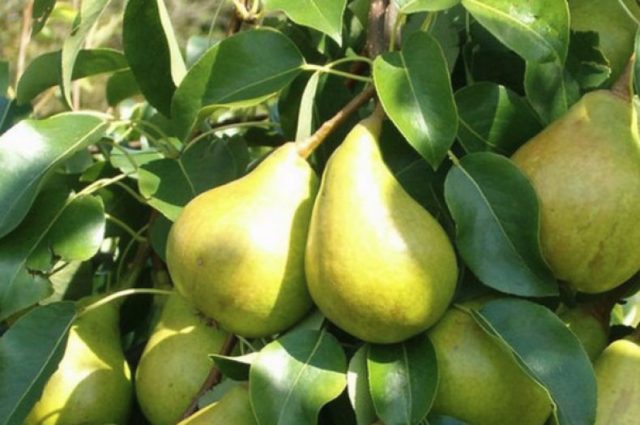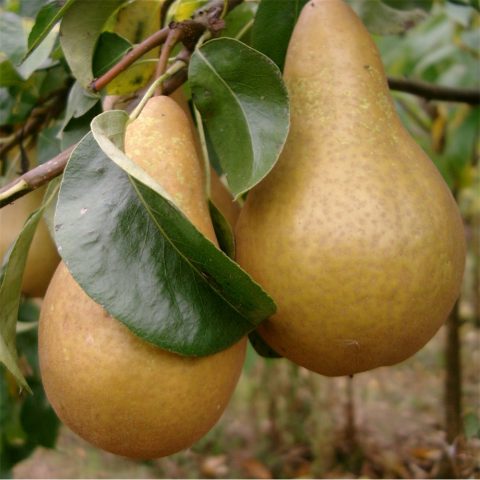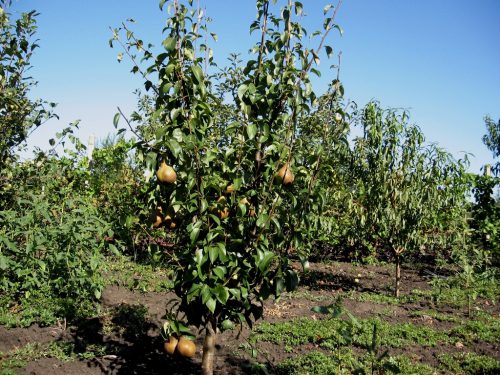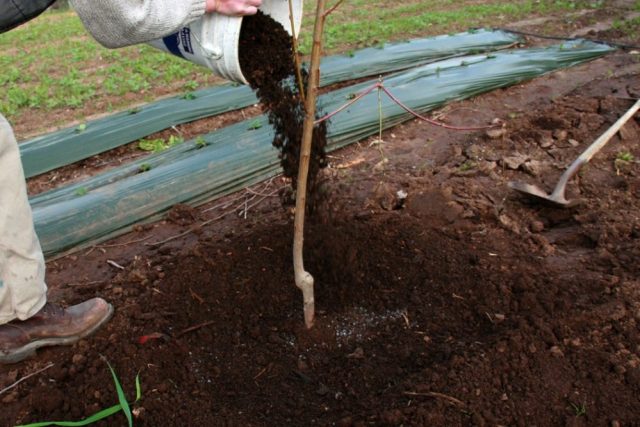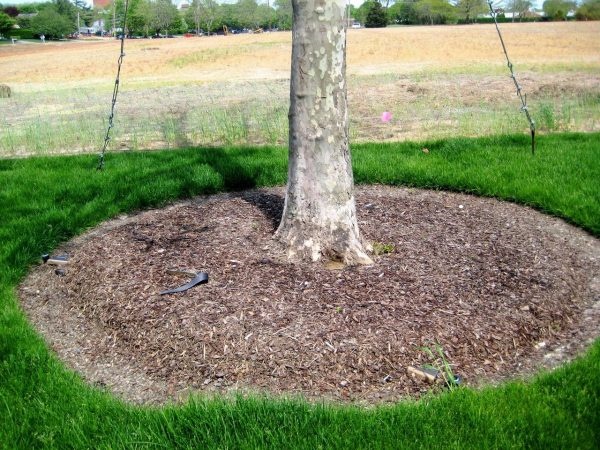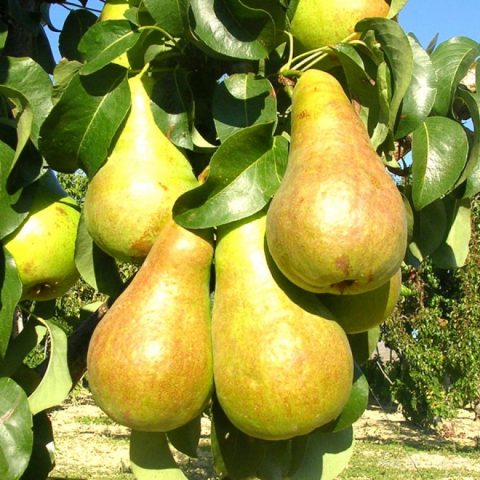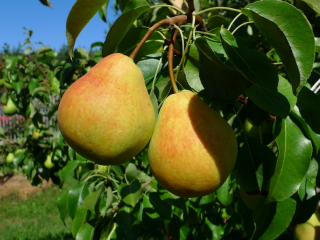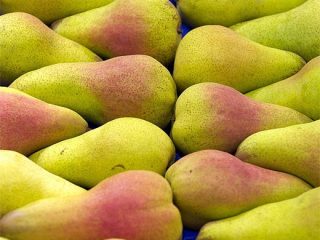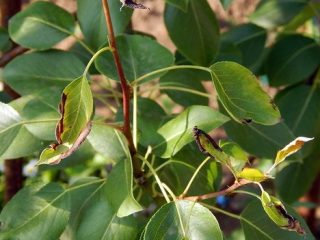Content
Description, photos and reviews of the Bere Bosk pear are of interest to owners of private gardens from different countries. It is an old variety native to France. Tests were carried out on the territory of Russia, after which it was entered in the State Register in 1947. Pear Bere Bosk is recommended for cultivation in the republics of the Transcaucasus, the gardens of the Stavropol Territory and in the Crimea.
Description of pear variety Bere Bosc
A vigorous tree, characterized by active growth in 1-2 years of life. The spreading crown consists of long, massive branches covered with rough gray-brown bark. It is rather rare and asymmetrical. In mature trees, it acquires a wide pyramidal shape.
Lentils are small, often placed on shoots. Lances and ringlets are places where fruits are formed. The petioles of the leaves are short, slightly more than 1 cm. The surface of the sheet plates is smooth, dark green colored. The shape of the plates is elongated, ovoid, the edge is solid.
Variety Bere Bosk - autumn, late, so the buds bloom when the threat of recurrent frosts has passed. Blooms profusely. The flowers are large, white, grouped in voluminous inflorescences, in 1 there can be more than 10 pieces. There are 1-6 ovaries in the brush.
The level of winter hardiness at pear varieties Bere Bosk is low. In some frosty winters, there was a strong freezing of trees in the Crimea. The frost resistance of Bere Bosk is not enough even for the gardens of the Krasnodar Territory. Drought resistance indicators are low.
Characteristics of pear fruits
The peculiarity of the Bere Bosk pear is the fruit of various shapes (bottle, elongated pear-shaped). It is different within 1 tree. This corresponds to the varietal description as seen in the photo. The size of Bere Bosc fruit is medium to large.
The mass of an average pear is 180 g, but it can vary in the range from 150 to 250 g. The fruit is covered with a thin, slightly rough skin. The main color is yellow-brown, rusty spots are visible on most of the surface. During storage, the color becomes golden yellow, almost bronze.
Fruits hang firmly on thick, slightly curved stalks. They do not crumble even with strong gusts of wind. The funnel is not pronounced, the calyx is open, the shape of the seed nests is bulbous. Seeds are small, dark in color.
The taste of Bere Bosc fruit is delicious. It is sweet with spicy notes and an almond flavor. The flesh can be pure white or slightly creamy. It is juicy, has a delicate structure, a little oily. Its chemical composition:
- 14.7% dry matter;
- 9% sugars;
- 0.2% titratable acids.
The fruits of Bere Bosk are stored for no more than 40 days, they tolerate transportation well. Their taste deteriorates when stored in the refrigerator. They lose their juiciness. The structure of the pulp changes, it becomes dry, crispy. Some of the fruits taken from the tree are not ripe. Their ripeness occurs in 2-3 weeks.
Pros and cons of pear varieties Bere Bosc
The advantages of the variety include the large size of the fruits, the yield, which grows with age. The pear is undemanding to the composition of the soil. With regular watering, it bears fruit abundantly on light (sandy, sandy loam) soil. Pear Bere Bosk is resistant to scab and most fungal diseases.
Cons of the variety:
- low winter hardiness of young trees;
- low drought resistance;
- does not like drafts, wind;
- heterogeneous fruit shape;
- uneven ripening of the crop;
- the crown needs formative pruning.
Optimal growing conditions
The variety is warm and moisture-loving. The root system of Bere Bosk goes deep, so the distance to groundwater should be 2-2.5 m. Heavy and depleted soils are not suitable. The pear grows best on loose, light soils that are good for water and air.
Low-lying places, where rain and melt water stagnate for a long time, are not suitable for Bere Bosk pears. The site should be well lit by the sun. If it is protected from northern winds and is located in the southern (southwestern) part of the orchard, then the seedlings will feel great.
Planting and caring for a pear Bere Bosc
You need to buy 1-2-year-old seedlings of Bere Bosk. They adapt faster. The pear is grown in the southern regions, so they are planted in the spring before the buds swell or in October. They do not spare time to prepare the land:
- the site is dug up;
- remove the roots of perennial weeds;
- add humus, mineral fertilizers;
- sand is added to improve the structure.
Landing rules
An adult tree has a wide-pyramidal crown, therefore, seedlings are planted at a distance of 3-4 m from buildings, trees, fences. Pits are dug deep (1 m) and wide (0.8 m). The root system of a pear is powerful and requires nutrients to form.
When buying a seedling, it is assessed. Signs indicating its quality:
- there is no damage on the bark, it is smooth, even;
- root length - at least 25 cm, the number of main roots - at least 3-5 pcs.;
- the roots are not overdried, they do not break when bent, and when cut they are white.
A stake is driven into the center of the pit, garden soil mixed with sand, humus, superphosphate, and ash is poured into a mound. A seedling is placed on it, its roots are straightened and covered with earth tightly, leaving the root collar outside. There should be at least 5 cm from it to ground level.
The trunk is tied to a support in 1-2 places. It should be on the south side of the peg. An annual seedling is shortened to 0.8-0.9 m. In two-year-olds, all skeletal branches are shortened by ⅓. Decrease the length of the center conductor. Its crown should be 20 cm higher than the upper tier of branches.
Saplings of the first 2 years of life require special attention. Mandatory measures for their care:
- regular watering;
- clearing the trunk circle from weeds;
- top dressing;
- loosening the soil;
- preventive treatments for pests and diseases.
Watering and feeding
The pear loves watering. The fruiting tree Bere Bosk is watered up to 5 times per season. If it is hot in summer and there is no rain, then the amount of watering is increased. Water consumption for root irrigation 30 l / m². In arid regions, drip irrigation is organized, the soil is mulched to reduce evaporation.
The feeding scheme is made based on the age of the tree. For the first 2 years, the pear does not need fertilization. Those dressings that were laid in the pit during planting are enough. Starting from 3 years old, the tree is fed:
- in the spring they are sprayed with a solution of a complex fertilizer (Nitrofoska, Ammophos);
- annually bring humus into the soil - 6-10 kg / m²;
- in the fall, ash is introduced into the trunk circle.
An approximate scheme of root dressings for Bere Bosk is given in the table.
| Period | Fertilizer type | amount |
| Spring | Urea | 200 g per 10 l |
| Summer (June) | Urea | 30 g per 10 l |
| Summer (July, August) | Superphosphate | 30 g / m² |
| Potassium salt | 30 g / m² | |
| Autumn | Superphosphate | 30 g / m² |
| Ash | 1 tbsp. |
Pruning
In the spring, they carry out obligatory sanitary pruning of pears. All shoots that have badly overwintered and damaged by disease, pests are subject to removal. For the first 4 years, the crown is formed every autumn. In the future, asymmetry is eliminated by shortening especially long branches. The branches of the lower tier of Bere Bosk are not touched, they are allowed to grow.
In the root zone of the pear, root growth grows. It is cut out in the fall. Pests hibernate in it. All cuts on the tree are smeared with garden pitch.
Whitewash
The stem and skeletal branches are whitewashed in autumn. In early spring, whitewashing will protect the bark from bright sunlight. Prepare it yourself or buy it in the store. DIY recipe:
- water - 1 bucket;
- clay - 1.5 kg;
- lime - 2 kg.
The mixture is applied to the lower skeletal branches and trunk from the ground to the lower tier.
Preparing for winter
In autumn, the trunk circle is cleared of fallen leaves and weeds. During shallow digging, mineral fertilizers are applied to the soil. Before the onset of frost, the last (moisture-charging) watering is carried out.
The trunk circle is covered with mulch. Use peat mixed with humus, or rotted sawdust. To prevent the roots from freezing, the thickness of the mulching layer is made at least 15 cm. Young seedlings after the onset of frost are wrapped with covering material.
Pollination
This is a bee-pollinated variety. To obtain a good harvest, several Bere Bosk trees or pears of other varieties are planted in the garden:
- Williams;
- Bon Louise;
- Bere Napoleon.
Yield
The variety stands out for its productivity. 1 adult tree Bere Bosk yields 150-250 kg of fruit. The amount depends on the structure of the soil, its moisture content and weather conditions. Pears begin to bear fruit at the age of 5-7 years.
This variety is used in industrial gardens. A record figure of 300 kg of pears from 1 tree was recorded in the Krasnodar Territory. Fruit harvesting begins in early September.
Diseases and pests
The variety is noted to be resistant to fungal and bacterial infections. But Bere Bosk has a probability of illness. Using dirty garden tools can cause bacteria to burn in the wood during pruning. Symptoms of blackened young pear branches and leaves appear in early summer. The tree is treated with antibiotic solutions:
- ziomycin;
- penicillin;
- agrimitin.
Damp warm weather can cause the development of scab - a common fungal disease of leaves, fruits, shoots. The affected areas are covered with gray or brownish-green bloom. Sick trees are sprayed with a urea solution, the soil is watered with a fungicide.
In rare cases, Bere Bosk suffers from other diseases of pears, apple trees:
- fruit rot;
- ulcerative cancer;
- cytosporosis;
- phyllostictosis.
The gall mite is dangerous for the pear. You can find out what drugs you need to use to combat it from the video:
Reviews about pear Bere Bosk
Conclusion
Description, photos and reviews of the pear Bere Bosk explain the secret of its long-term popularity. It is very convenient to have a powerful tree in your garden that bears fruit for 50 years or more. A mature tree does not take much time to care for. Every year Bere Bosk pleases gardeners with a stable harvest. Pear rarely suffers from diseases and pests.
